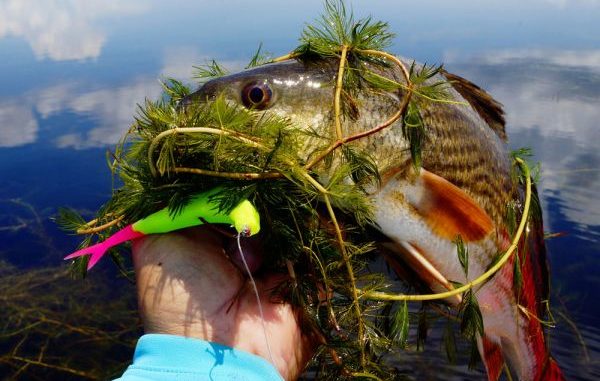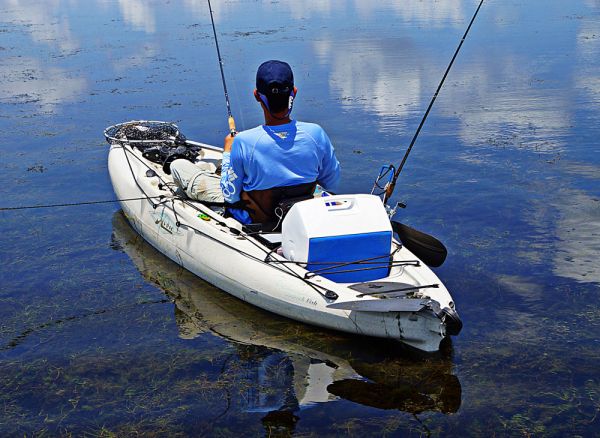
’Yaks make perfect stalking platforms
The heat of summer is in full swing, and many of the shallow marsh ponds are choked with submerged aquatic vegetation. The grass is so thick that it prevents powerboats from accessing these areas, and this is great news for kayak fishermen.
Lurking beneath that grass are hungry redfish, and the best way to get to them is with a paddle craft.
Some of the best areas will, at first glance, seem impenetrable. Outboards will overheat, trolling motors will get wrapped in grass and bog down.
However, a kayak can be paddled or poled through the grass to where the reds are hiding.
One of the first things you will notice is how clear the water is. The vegetation filters the dirt, and most spots will be as clear as an aquarium. Baitfish and crabs teem in the grass, and the reds are there to gorge on them.
The stealthiness of a kayak allows you to get into the grass and up close to the reds.
The key is to keep the kayak light and snag free. If you have a pedal kayak, leave the pedals at home or pull the drive out to get through the grass. If you have a rudder, leave it up.
With a stiff paddle or push pole, you are able to easily glide over the grass.
You’ll only need a handful of lures, so limit your gear, and you can easily move around in the thickest of grass-filled ponds.
Though some areas look like solid patches of grass, there are usually small pockets of open water and deeper channels that course through the jungles. Oftentimes, there are small guts that run near the shoreline. The reds use these channels to maneuver through the area and ambush anything that strays into the open water.
Don’t shy away from fishing those areas that look more like a farm field than a fishing pond.
You won’t be using any lures with treble hooks here. Limit your lure selection to light-weight baits that work on and through the grass without getting hung up. Soft-plastic jerk baits with concealed hook slots, weedless frogs and small, weedless spoons all get the job done in the thick grass.
Paddling through the grass will often spook fish before you see them. It’s best to work your way into a spot as quietly as you can. Put the ’yak onto the thick grass and you likely won’t need to anchor. If you do, use a stake-out pole to hold your spot.

Thoroughly fish the area 360 degrees before moving on. While blind casting can be effective, patiently waiting and scanning the grass for movement will help pinpoint specific fish locations. It’s difficult for the fish to move through the grass without giving up their presence.
Look for bait jumping, grass moving, wakes or other telltale signs of fish. However, not all movement will be redfish. You will also encounter lots of mullet and garfish.
Reds typically push a straight V-shaped wake, while mullet have an erratic wake that frequently changes directions. Most gars will be lingering just below the surface and not moving much.
Quality polarized glasses allow you to spot reds more easily in the clear water. Keep in mind that they will be able to see you more easily, too. Wear light-colored clothing and move slowly, especially if standing.
Sunny days with little wind are best for sight-fishing.
If you spot a red, try to determine which way it’s facing or moving. Make your cast well beyond the fish, and slowly work the lure at an angle toward but not directly to the fish. The red will sense the lure as it gets close, and if it’s hungry it will attack.
Hooking reds in thick grass is more difficult than in open water. Additionally, hooks embedded in the bait or protected with a weed guard take a little more force to get the hook into the fish’s mouth. Set the hook hard, and set it once or twice more just to make sure. Using braided line eliminates line stretch on hookset and also helps reel in a fish that may have a few extra pounds of grass wrapped on its head.
Reds will also explode through the grass to hit baits slowly worked on the surface. They just can’t seem to resist a weedless frog slowly hopped across the grass. The red may get a mouthful of grass along with your bait, so you will miss some fish, but the excitement is worth it. Work the frog or jerk bait across the thick grass and allow it to drop into any small open water pockets.
If you have a good sense of balance and a stable kayak, standing and sight-fishing can be rewarding. The trick is to spot the reds from as far away as you can. This allows you time to switch from paddle/push pole to rod without spooking the fish. A belt clip avoids having to stoop and set the paddle or pole down, allowing you to keep your eye on the fish.
If you spook a fish, chances are it won’t go far. Stay put for a while and watch the area where it was last seen. It will likely show up again and you’ll get a second chance.
Fly rods are great weapons to pursue reds in the grass. Light-weight flies allow you to quietly land a lure without spooking fish. Use a fly with a monofilament weed guard to keep it from getting fouled with grass.
Seeking out grass-filled ponds gives kayak anglers access to fish that are virtually untouched during the summer months. You won’t have to contend with powerboats and a limit of redfish is almost guaranteed.
This is one time when being “in the weeds” is a good thing.


